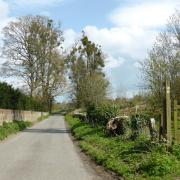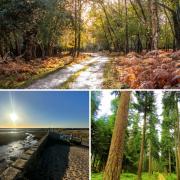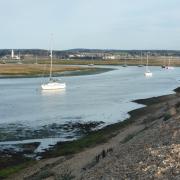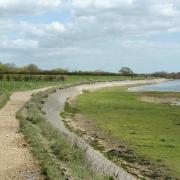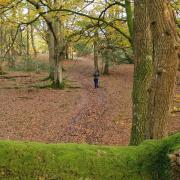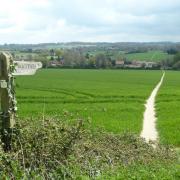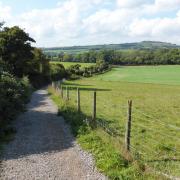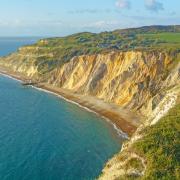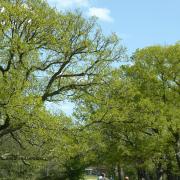From the high downland in the north of the county to the Solent coast in the south, Hampshire has some of the most varied countryside in southern England, with plenty of choice for four-legged friends says Fiona Barltrop
Old Winchester Hill
Despite its name, Old Winchester Hill is actually about 11 miles south-east of the city, on the route of the South Downs Way. The hill is crowned by an impressive Iron Age hill-fort within which are a number of Bronze Age barrows. It is also a National Nature Reserve important for its flower-rich chalk grassland, and designated as Open Access Land. This means you can walk freely over it; however, dogs need to be on a short lead between March 1 and July 31 to avoid disturbing the wildlife. Much of the ascent is along good paths and tracks with fenced fields either side, so dogs can be off the lead until entering the reserve higher up.

1 (SU617212) Cross the A32 just beyond the parking area, and follow the South Downs Way (SDW) path to a footbridge over the River Meon – a lovely spot. 150 yards further on turn left and follow the path beside the ditch. This leads to the old railway line, now the route of the Meon Valley Trail – steps down from the path and then up to it. Go straight across the track and down steps on the other side and continue down the path, then bear right across a footbridge and left. The track bends right and then turns left, continuing alongside fields on the left, heading steadily uphill.
2 (SU634206) At the junction where the Monarch’s Way joins from the left, keep ahead along the right-hand side of the hedge, field on the right. At the end of the field by the next fingerpost, turn left through a gap in the hedge and immediately right. Continue up the enclosed path, soon reaching the Old Winchester Hill information panel. Carry on uphill to go through a gate and thence on up the open grassy slopes to the top. Keep ahead to the trig point, then continue across the grass to the hill fort information panel.

3 (SU642204) Go through the kissing gate and turn immediately right through the bridle gate. The fenced path bears round to the right then turns left and descends quite steeply. At the bottom turn right alongside the hedge on the right, field on the left. Keep ahead at the junction and soon go through a gap in the hedge continuing with the hedge on the left, fence on the right.
4 (SU635204) At the T-junction turn right, then left at the next retracing your outward steps. (Alternatively, turn left, then right down to Stock’s Lane and right along that to join the Meon Valley Trail, turning right, then left back along the SDW.)

Compass points
Start/finish: Parking area at north end of Church Lane, near junction with A32 (SU617212)
Map: OS Explorer 119
Distance: 4 miles (6.6km); longer option 5 miles (8km)
Terrain: Chalk downland – footpaths and bridleways; quiet country lane for longer option
Time: 2 hours (or 2½ for longer option)

Farley Mount
Farley Mount Country Park, an area of beautiful downland and woodland, is situated a few miles west of Winchester. Its most notable feature is the Farley Mount monument, a white pyramid shaped folly in honour of a horse. There are far-reaching views from up here - on a clear day the Isle of Wight can be seen. The Clarendon Way, a 24-mile route linking Winchester and Salisbury, runs through the site. This walk follows a stretch of it for the outward leg and returns through Parnholt Wood, passing Farley Mount both at the beginning and end of the walk. Dogs can be off the lead for much, if not all, of the way.
1 (SU408293) There are several car parks quite close to one another at Farley Mount Country Park. This walk starts from the westernmost one nearest the monument, but if full, you can easily walk here from one of the others. Follow the path from the car park and after c.500m fork left and up the grass to Farley Mount. The monument, which you can go up to, sits atop a mound. A plaque tells you about the horse.
2 (SU402290) Return to the main path turning left and almost immediately fork right along a grassy path keeping near the fence on the right – this provides better views than the main path, which it re-joins before long. Carry on to a junction where a restricted byway turns left (your return route).

3 (SU397290) Keep ahead along the signed Clarendon Way (CW), descending to reach a lane. Just before it turn left, still following the CW. After passing a bridleway turn on the left keep ahead when the CW bears right. This leads to Hoplands where you continue along the road until you reach a byway signpost on the left.
4 (SU368301) Turn left here and follow the track/byway south then east through Parnholt Wood to a signed intersection. Shortly before this the route becomes a restricted byway (no vehicles).
5 (SU391284) Turn left along the wood-lined track back to waypoint three. Retrace your steps to the start.

Compass points
Start/finish: Monument car park, Farley Mount Country Park (SU407293) or nearby Juniper car park or one of the others along the roadside to the east
Maps: OS Explorers 131 & 132
Distance: 6⅓ miles (10.2km)
Terrain: Fairly easy walking (gentle gradients) along clear paths and tracks over open downland and through woodland
Time: 3 hours

Fritham, New Forest
Situated in the northern half of the New Forest, the village of Fritham is well known for its award-winning pub, the charming 17th century Royal Oak. From the 1860s to the 1920s, surprisingly the village was home to the Schultze Gunpowder Factory, which manufactured smokeless gunpowder, used for sporting guns. Man-made Eyeworth Pond, passed near the start of the walk, provided water for the manufacturing process.
During the Second World War the establishment of the nearby Ashley Walk Bombing Range – also passed on the walk – shattered the peace of the area even more. A vast area of heathland was used as a bombing range to test a huge variety of explosives.
1 (SU230140) Return to the car park entrance where you turn left, but just before the road note the small information panel about the black metal post box behind it. This was put here by the Schultze Gunpowder Factory to make the postman’s life easier in the days before delivery vans. Follow the road down passing on the right picturesque Eyeworth Pond, which was created by damming a brook to provide water for the factory, based at Eyeworth Lodge. Continue past the Lodge to Oak Tree Cottage and carry on along the path to the right of the barrier heading northwards through Eyeworth Wood. Emerging from the wood the path continues north-east across Homy Ridge heath to a junction by a Scots Pine on the right. Bear left here heading north-west gently downhill and up again to the Telegraph Hill car park.
2 (SU228166) Turn left at the road and almost immediately left again along a track which leads you over the heath in a southerly direction towards Amberwood Inclosure. Ignore turns, keeping to the main track to the west of Islands Thorns Inclosure, passing a pool on your right. Just before Amberwood Inclosure note a small brick building over to your right. In it – a former World War II observation shelter – there’s an information panel about the bombing range for which this peaceful heathland was once used.

3 (SU207141) At a T-junction on the edge of Amberwood Inclosure join a gravel track/cycle route (these are marked with numbered wooden posts across the New Forest). Turn left to return to the car park at Fritham.

Compass points
Start/finish: Fritham car park (Forestry Commission) beyond pub (SU230140)
Map: OS Explorer OL22
Distance: 5¾ miles (9.2km)
Terrain: Forest and heathland paths and tracks. Short stretch along quiet no-through road at start. Since it is open access land you can roam freely, but from March to July avoid signed areas where there are ground nesting birds, keeping dogs on leads.
Time: 2½ - 3 hours

7 other dog-friendly walks
North Hampshire Downs
Start: Whitehill viewpoint/car park on B3051, south of Kingsclere (SU515564).
Stride out westwards along the top of the ridge, enjoying wonderful views and give the dog a good run, too. Return the same way.
Basingstoke Canal
Start: Barley Mow car park, Sprat’s Hatch Lane, near Barley Mow pub, Winchfield (SU778537).
Turn left out of the car park and follow the towpath (canal on right) to Blacksmith’s Bridge. Cross it and continue along footpath past Tundry Pond, keep right at fork via Sprat’s Hatch Farm back to towpath and turn right back to the car park.
Selborne Common
Start: Selborne car park behind Selborne Arms (SU742335)
Climb the zig-zag path up Selborne Hill that the renowned 18th century naturalist Gilbert White and his brother constructed, and explore the NT’s Selborne Common paths.

Queen Elizabeth Country Park
Start: Queen Elizabeth Country Park main car park at entrance (SU718185)
Plenty of open access woodland and downland to explore, with waymarked trails and a dog activity course, fun for you and your four-legged friend.
Spearywell Wood, Mottisfont Estate
Start: NT car park, Spearywell Wood, off B3084 north of Romsey (SU315276)
Explore the NT’s Mottisfont estate, taking in woodland, farmland and the crystal-clear River Test.

Hurst Spit
Start: Keyhaven pay & display car park (SZ306914).
Follow the Solent Way along the shingle beach of Hurst Spit out to Hurst Castle (dogs welcome on leads). Return same way or take ferry when running.
Lepe Country Park
Start: Lepe Country Park car park (SZ455985)
Good for all the family, dogs welcome, too (except on the family friendly beach, located in front of the beach car park, between April and September). Try the 5-mile Lepe Loop coastal and countryside route.
Always keep dogs on leads near grazing livestock, especially during spring, with the lambing and calving season well under way. Dogs on leads, too, between March and July where there are ground-nesting birds in the area.







